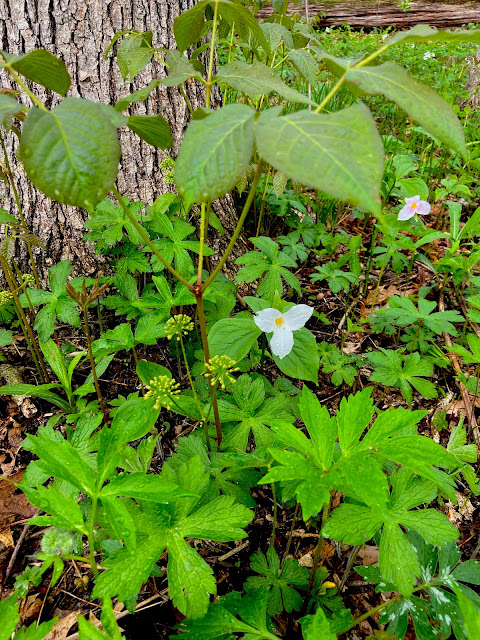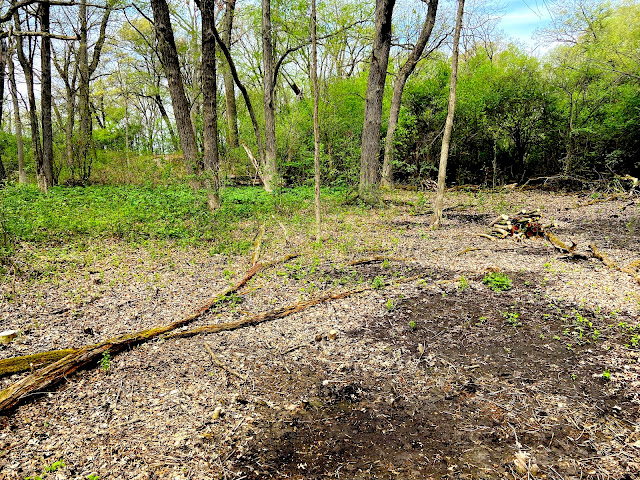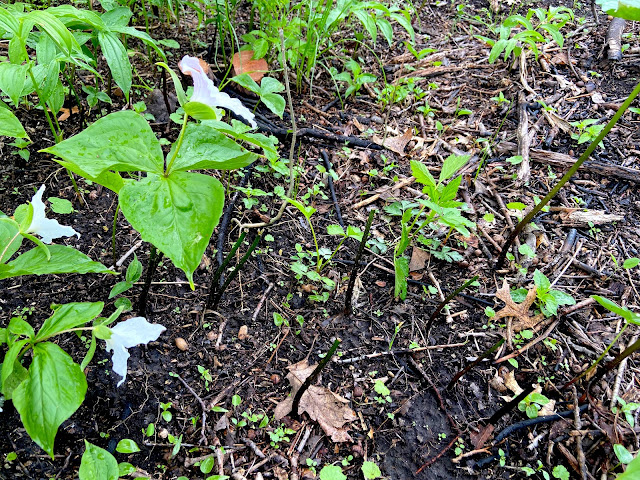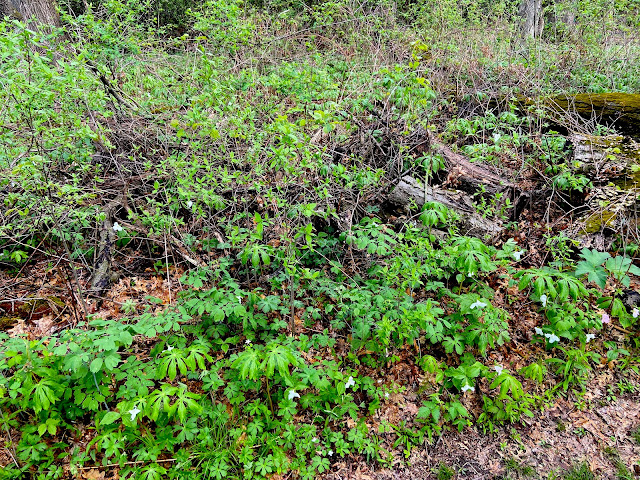Below, we pull some metal fenceposts ... and some garlic mustard.
But after months of prairie burns and brush bonfires, today richness explodes into magic.
It's a time for learning - and re-thinking.
We start with the photo below, what does it make you think? What does it mean?
We're thrilled by the holy beauty of spring unfolding. And yet this photo also indicates trouble. A diminution of diversity. More about that later.Next we are stuck by the large number of conservative species in little Shaw Woods. For example:
This treasure could escape your notice at first. Check out those big leaves at the top - and the spherical flower clusters rising from the base - formerly common, a rare plant these days - sarsaparilla (Aralia nudicaulis). People made root-beer from it ... and for that purpose its name was shortened to "sasparilla."To find a high-quality woods next to high-quality prairie and savanna remnants is rare. This woods is packed with doll's-eyes, long-beaked sedge (Cx. sprengelii), long-awned woodgrass, and a long list of classy species (more of which you'll see below).
We happily employ brawn to pull fenceposts - the last stage in removing a rusting metal fence that has long been a useless eyesore in this part of the preserve.
At break time, we eat treats, relax, teach, and discuss.
Here, even right next to the trail, a rich turf stops abruptly, as brush and piled logs take over. There will be plenty of accomplishment begging for our attention when the cold returns.
As for the Friends, we make space for the reproduction of such species with the winter cut-and-burn work and, today:
... making the most of a once-a-year expanded Garlic-Mustard-Pullers team.At break time, we eat treats, relax, teach, and discuss.
It's increasingly obvious to all that this is not just any old wild place. Richness survives here.
The diversity in this photo is that of a fine woodland. Rue anemone (lower left, seven petal flower, in this case; they vary) and trillium (three petals) bloom now. Soon the wild columbine (see rue-like leaves towering above the anemone's) will be attracting humming birds with its pink flowers. The yellow mayapple fruits (forming under the big, divided leaves, top right) will attract hungry mammals of many kinds, including us. Penn sedge (grass-like) holds the turf together.
Here the white trillium is joined by the pale foliage and yellow flowers of the blue cohosh. Those yellow flowers don't stand out, but the deep blue fruits will make their statements from summer through fall. Also in this photo are the developing leaves of later-to-bloom wild geranium, Chicago leek, and false Solomon's-seal, all indicators of woodland health. But here - the narrative goes dark. (Sound of eery music, please.) Dead wood is heaped in many places in this preserve, snuffing out quality plants and the animals that depend on their leaves and fruits. Yet more insidiously (eery music now swells). The bad plant in this photo (trust us, if you can't tell it by its leaves) is the rank tall goldenrod, a killer species. It and its ilk now dominate some areas where buckthorn was removed, years ago. Why?
Other areas have nothing left. The next two photos below tell that story:
In the foreground is bare dirt, all that's left in one of the areas where we cut brush last winter. The invasives had killed all. To the top right, the dark brush remains - to be cut next winter.
Friends, Lake Forest Open Lands, volunteers, staff, and contractors have launched a major restoration initiative at Shaw, including the woods, savanna, wetland, and prairie. The blighted result visible below was revealed by Open Lands' contractor work with mighty machines:
This large piece in the center of the Nature Preserve (between Shaw Woods and Shaw Prairie) had its brush cut last winter. Long ago, this was prairie, marsh, and savanna. Ditching and brush had eliminated the natural ecosystem nearly entirely. To use medical metaphor, this was major surgery. Our challenge now is to prevent this land from falling to the invasives. A battle awaits.
In the areas below, brush was removed many years ago, but today it's essentially "all weeds." We try to avoid this by sowing the right seed to facilitate recovery of biodiversity:
Indeed, so that today's volunteer team could get in here, the week before (not seen here) the regular ever-so-dedicated Friends volunteers cut out great quantities of prickly briars. We pulled the scattered garlic mustard, especially from the highest-quality and most sensitive-to-trampling areas. Today is for big concentrations. Next week we'll do more detail and "quality control." About those briars: Are they natural? Emphatically yes and no.

The word briars applies to native and alien species of dewberries, raspberries, blackberries, and other prickly, shrubby fruits. They taste good and play important roles in shrubland ecosystems. But the ones that tend to fill recently cleared area are impediments to recovery of classic open woods or open prairie.

The word briars applies to native and alien species of dewberries, raspberries, blackberries, and other prickly, shrubby fruits. They taste good and play important roles in shrubland ecosystems. But the ones that tend to fill recently cleared area are impediments to recovery of classic open woods or open prairie.
From the perspective of biodiversity conservation, the vast beds of trillium-and-little-else are also ambiguous at best. In the seminal Vegetation of Wisconsin, John T. Curtis describes concentrations of these great white trilliums as a near-terminal stage of what happens to an oak woods as it becomes too dark for most of its flora. (And, though the botanist Curtis didn't say so, the darkening also gradually wipes out the associated invertebrates, other animals, fungi, etc.). Our strategies seek to maintain large numbers of trilliums as the richness of other species returns as well.
In the photo below, another wrinkle. Notice all those stems that stand alone:
At least seven stems have been chewed off by the deer. In some woods, the trilliums have been wiped out by too many mouths. The existing programs to control deer numbers are good and deserve to be supported.
Here a deer exclusion cage will protect the trilliums inside. We'll be able to compare inside and outside from year to year.
As we stewards head into very different summer work, as we often do, we take a bit of time to study what today's ecosystem tells us about needs for next fall and winter.
Here the trilliums gradually fade out, and the brush shade deepens, and no quality plants survive.As we stewards head into very different summer work, as we often do, we take a bit of time to study what today's ecosystem tells us about needs for next fall and winter.
Here, some of us are posing. We have great will and intention, to change the world, for the better in this case.
















No comments:
Post a Comment